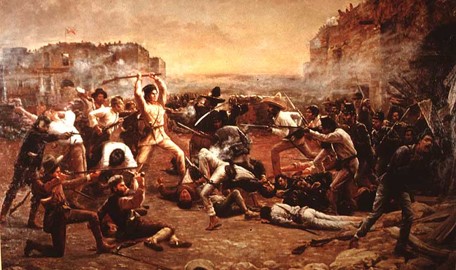On February 23, 1836, Mexican General Santa Anna began a siege against nearly 200 Texan rebels stationed inside the Alamo. He launched an assault 12 days later, killing all the rebels but sustaining costly losses.
Texans Refuse to Surrender at Alamo
Mexico, which included Texas and much of the present-day American southwest, won its independence from Spain in 1821. To encourage colonization, the new government allowed settlers of any race to claim land. Many Anglo-Americans immigrated to Texas during the 1820s, many under the guidance of Missouri-born settler Stephen F. Austin.
In 1833, Mexican General Antonio Lopez de Santa Anna became president and began centralizing power: the Mexican federal constitution was rescinded, state militias were reduced, and state legislatures were dissolved. Santa Anna’s action sparked rebellions in several Mexican areas; one such rebellion, in Zacatecas, was brutally suppressed in May 1835 by Santa Anna, who ordered that the city be pillaged.
Texan (or Texian) immigrants and Tejanos, the original settlers in the area, formed an army to fight for independence. In the fall of 1835, the Texan rebels—under the command of Austin, who had spent 1834 in prison after he asked for independence—defeated Mexican forces at Bexar (San Antonio). They seized control of the town and the Mission San Antonio de Valero, also known as the Alamo, a major strategic fort.
The Alamo’s position prevented Santa Anna’s Mexican Centralist forces from marching right through Texas and suppressing the insurgency. Stationed inside the fort were roughly 150 rebels, many of whom had wives and children living with them.
Santa Anna’s army reached the fort on February 23, 1836, and demanded surrender; the Texans, under the command of James Bowie and William B. Travis, responded by firing a cannonball. Santa Anna’s troops launched artillery attacks on the fort as the rebels desperately called for reinforcements.
Travis sent out a letter “To the People of Texas and All Americans in the World” on February 24. It read: “I shall never surrender or retreat. Then, I call on you in the name of Liberty, of patriotism & everything dear to the American character, to come to our aid…If this call is neglected, I am determined to sustain myself as long as possible & die like a soldier who never forgets what is due to his own honor & that of his country—Victory or Death.”
After 12 days, the forts walls were deteriorating and the rebels were running out of provisions. Santa Anna, rather than waiting for the weakened rebels to surrender, decided to launch an assault.
Santa Anna’s troops, who numbered in the thousands, began their assault on the morning of March 6. The rebels, who numbered between 180 and 190, were able to repel two charges, but they were overwhelmed by the third.
“Fighting was hand to hand with knives, pistols, clubbed rifles, lances, pikes, knees and fists,” describes Lee Paul in Wild West magazine. “The dead lay everywhere. Blood spilled in the convent, the barracks, the entrance to the church, and finally in the rubble-strewn church interior itself. Ninety minutes after it began, it was over.”
Just seven of the rebels, possibly including legendary frontiersman Davy Crockett, survived, but they were immediately executed. Santa Anna did spare the lives of the women and children in the fort.
Sources in this Story
- PBS: Remember the Alamo
- Handbook of Texas Online: The Battle of the Alamo
- Texas State Library: William Barrett Travis’ Letter from the Alamo, 1836
- HistoryNet (Wild West Magazine): The Alamo: 13 Days of Glory
- The Alamo: Texas Revolution
- Descendants of Mexican War Veterans: A Concise History of the U.S.-Mexican War
Later Developments: Texan Independence
Though he had secured the fort, Santa Anna lost approximately 600 men and wasted valuable time in his march north. During the siege on the Alamo, Texan rebels at a convention in Washington-on-the-Brazos declared independence from Mexico and formed the Republic of Texas.
Sam Houston was named commander of the Texan army and in April he attacked Santa Anna at San Jacinto. Texan rebels, who exclaimed, “Remember the Alamo!” during the fighting, won the battle and Santa Anna was captured, effectively ending the Centralist campaign to reclaim Texas.
The Republic of Texas was admitted into the United States in 1845, becoming the 28th state. Mexico objected, prompting the start of the Mexican-American War in April 1846. The two-year war ended with a United States victory; Mexico was forced to give up land that now makes up “California, Arizona, New Mexico, Nevada, Utah, and parts of Colorado and Wyoming” in the Treaty of Guadalupe Hidalgo.
Related Content
Key Players: Figures in the Texas Revolution
PBS presents biographies of the central figures of the Texas Revolution, including Austin, Houston, Santa Anna, Bowie and Travis.











